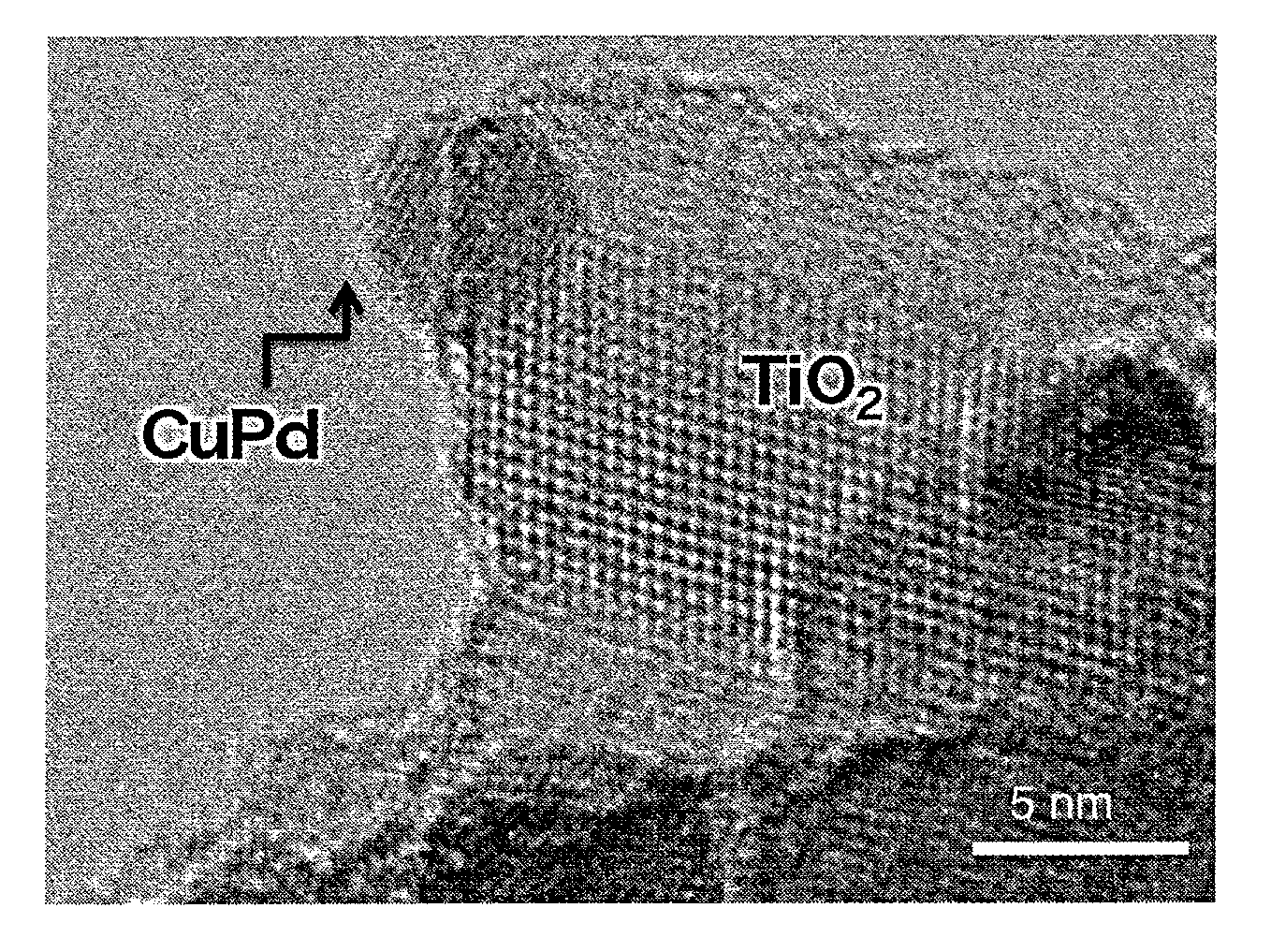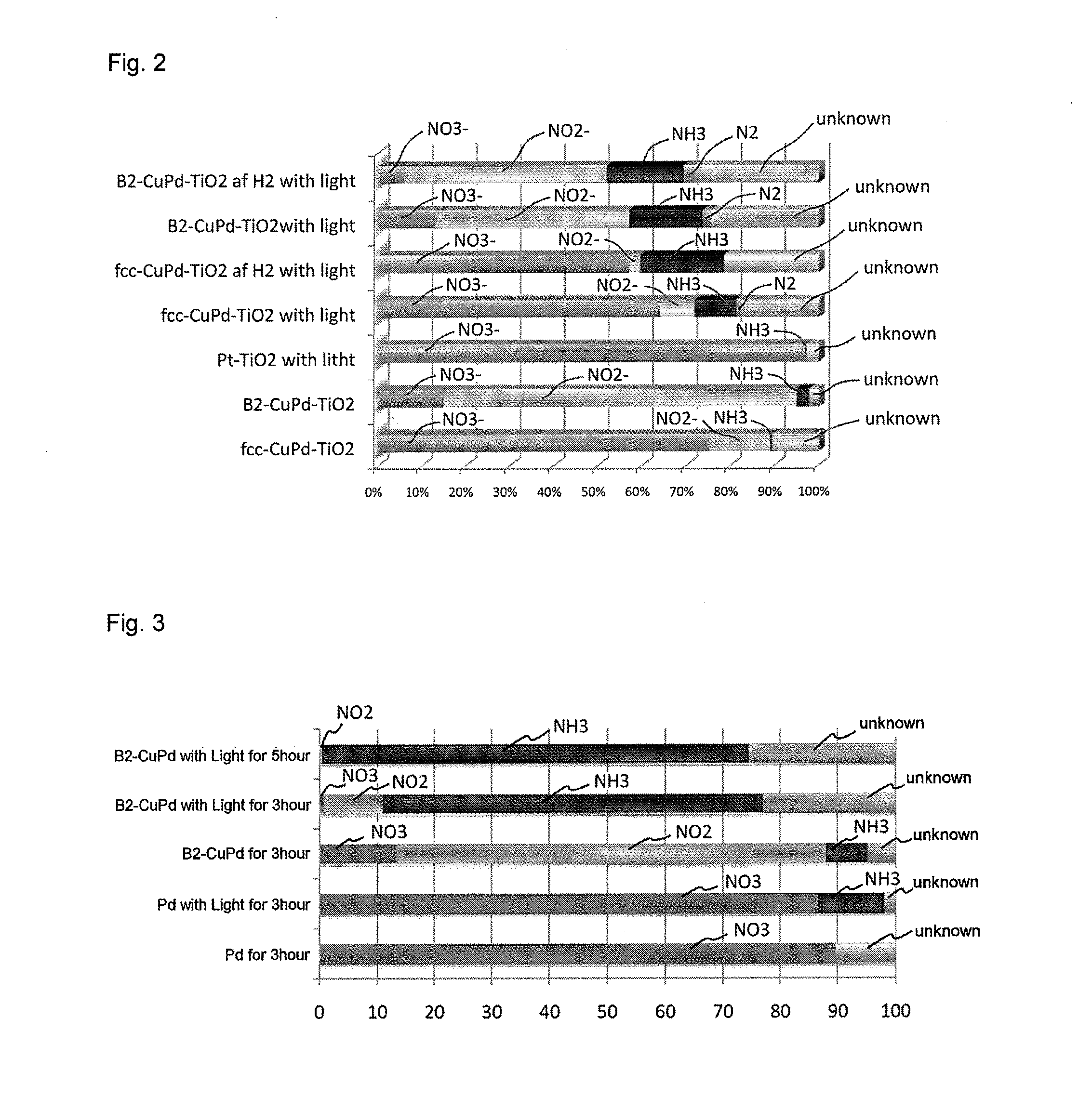Photoreduction catalyst, and method for synthesizing ammonia and method for decreasing nitrogen oxides in water using the same
- Summary
- Abstract
- Description
- Claims
- Application Information
AI Technical Summary
Benefits of technology
Problems solved by technology
Method used
Image
Examples
embodiment 1
(1) Preparation of the Catalyst
(Preparation of CuPd Alloy Nanoparticles)
[0092]Preparation of Disordered Fcc Type CuPd Alloy Nanoparticles
[0093]7.5x 10−4 mol of copper acetate was dissolved in 100 mL of ion-exchange water and 7.5 x 104 mol of palladium acetate was dissolved in 50 mL of acetone. These solutions and 1.5×10−1 mol of poly[N-vinyl-2-pyrrolidone] (NW=48,000) were mixed and ion-exchange water was added to prepare 300 mL of solution. The solution was cooled to 0° C. When 7.5×10−3 mol of NaBH4 dissolved in 100 mL of ion-exchange water was added at once, a blackish brown colloidal solution was obtained. Stirring was conducted for 30 minutes, followed by three repeat cycles of reprecipitation using acetone, water, and diethyl ether. The solvent and by-product inorganic compounds were removed, yielding disordered fcc type CuPd alloy nanoparticles (fcc-CuPd) (average particle diameter=4.5±1.7 nm).
[0094]Preparation of Ordered B2 Type CuPd Alloy Nanoparticles
[0095]7.5×10−4 mol of c...
embodiment 2
(1) Method of Preparing Small Diameter CuxPd(1-x) nanoparticles
[0109](0xPd(1-x) nanoparticles were prepared by changing the concentration ratio of Cu and Pd contained in the copper acetate and palladium acetate of the starting materials employed in synthesis.
[0110]The method of preparing Cu0.5Pd0.5 nanoparticles is indicated below.
[0111]In a glass tube, 0.3 g of copper acetate (1.5×10−3 mol) and 1.666 g of polyvinylpyrrolidone K30 (1.5×10−2 mol) were admixed with 10 mL of 2-ethoxyethanol. The mixture was dissolved by keeping for one hour at 1,300 rpm and 50° C. The dissolved solution was cooled to 30° C. In a separate glass container, 0.337 g of palladium acetate was dissolved in 15 mL of acetone. The palladium acetate solution was added to the copper acetate solution. A 0.227 g quantity of NaBH4 (6.0×10−3 mol) dissolved in 1.5 mL of Millipore water was added to the mixed solution of palladium acetate and copper acetate and the mixture was reacted for one hour with stirring at a spe...
PUM
| Property | Measurement | Unit |
|---|---|---|
| Electric potential / voltage | aaaaa | aaaaa |
| Particle diameter | aaaaa | aaaaa |
| Molar density | aaaaa | aaaaa |
Abstract
Description
Claims
Application Information
 Login to View More
Login to View More - R&D
- Intellectual Property
- Life Sciences
- Materials
- Tech Scout
- Unparalleled Data Quality
- Higher Quality Content
- 60% Fewer Hallucinations
Browse by: Latest US Patents, China's latest patents, Technical Efficacy Thesaurus, Application Domain, Technology Topic, Popular Technical Reports.
© 2025 PatSnap. All rights reserved.Legal|Privacy policy|Modern Slavery Act Transparency Statement|Sitemap|About US| Contact US: help@patsnap.com



